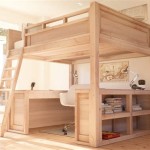DIY Bunk Bed Plans: A Step-by-Step Guide to Building a Full Over Full Bunk Bed
Building a bunk bed is a rewarding DIY project that can transform a bedroom and save valuable floor space. This article will guide you through the process of constructing a full over full bunk bed, providing detailed plans and tips to ensure a sturdy and safe structure.
Planning and Preparation
Before starting construction, meticulous planning is essential. This includes determining the size and dimensions of the bunk bed, selecting suitable materials, and gathering necessary tools.
1. Dimensions and Design
The standard full-size mattress measures 54 inches wide and 75 inches long. You can customize the height of the top bunk to suit your needs and the room's ceiling height, keeping in mind a minimum of 30 inches of clearance. Consider the overall dimensions of the bunk bed, ensuring it will fit comfortably in the chosen location.
2. Materials
For a sturdy bunk bed, select high-quality lumber like pine, cedar, or oak. Consider using pre-cut lumber for convenience, or if you prefer to cut the lumber yourself, ensure it is properly dried and free of defects. Additionally, you will need hardware such as screws, nails, wood glue, and corner brackets.
3. Tools
Essential tools for this project include a saw, drill, screwdriver, measuring tape, level, sander, and clamps. You may also require a router for creating rounded edges and a paint sprayer for finishing touches.
Construction Steps
Now that you have your plans and materials ready, you can start the construction process. Remember to work in a well-lit and ventilated area, and wear appropriate safety gear, including gloves, safety glasses, and a dust mask.
1. Building the Frames
The bunk bed frame is the foundation of the structure. Start by building the bottom frame, ensuring it is level and square. Then, create the top frame, paying close attention to the height and distance to the bottom frame. The frames consist of the side rails, headboards, and footboards. Secure the pieces together using wood glue, screws, and corner brackets for added strength.
2. Constructing the Slat Supports
Slat supports are essential for distributing weight and preventing sagging. Use 2x4s or similar lumber, attaching them across the frames with screws or nails. Ensure the slats are spaced evenly to create a stable platform for the mattress.
3. Building the Ladder
A sturdy ladder is crucial for accessing the top bunk. Design the ladder to fit comfortably and secure it to the side of the bunk bed using strong brackets. Consider adding handrails for safety.
4. Finishing Touches
Once the structure is complete, sand all surfaces to remove rough edges and prepare for finishing. Apply paint, stain, or other finishes according to your preference. Ensure the paint is safe for children and dries completely before assembling the bunk bed.
Safety Considerations
Safety is paramount when building a bunk bed. Always work within your skill level and consult with a professional if needed. Consider the following safety points:
1. Guardrails
Install strong guardrails around the top bunk to prevent falls. Use sturdy lumber and secure them with screws and brackets. The guardrails should be a minimum of 10 inches high and ideally even higher for added safety.
2. Mattress Fit
Use mattresses that are the right size for the bunk bed frames. Ensure that the mattresses fit snugly within the frames, preventing movement and potential falls.
3. Stability
Regularly check the structure for stability and signs of wear. Tighten loose screws and brackets and address any potential hazards promptly.
Tips for Success
Building a bunk bed can be challenging, but following these tips can increase your chances of success:
1. Measure Twice, Cut Once
Accuracy is crucial in woodworking. Double-check all measurements before making cuts.
2. Use Strong Hardware
Choose quality screws, brackets, and other hardware for durability and long-lasting support.
3. Pre-Drilling Holes
Pre-drill holes for screws to prevent wood splitting and ensure a smooth assembly.
4. Sanding and Finishing
Smoothly sand all surfaces before finishing to create a professional and durable finish.
5. Safety First
Always prioritize safety during the construction process. Wear appropriate safety gear and follow instructions carefully.
Conclusion:
Building a full-over-full bunk bed is a challenging but rewarding DIY project. By following these detailed plans, gathering the necessary materials, and attending to safety considerations, you can create a functional and beautiful piece of furniture that will add value to any bedroom.

Full Over Bunk Bed Plan How To Build Mattres Size Instruction For Diy Double Beds With Drawers

Diy Built In Bunk Beds Lauren Koster Creative

Make Diy Full Over Bunkbed For Your Kids With Free Plans If Only April

Twin Over Full Bunk Bed Plans Size Toddler Diy Beds Plan Kids Platform Loft Wooden

Farmhouse Style Twin Over Full Bunk Bed Plans Her Tool Belt

2x4 Bunk Bed Rogue Engineer

Simple Bunk Bed Plans Twin Over Full Ana White

Make Diy Full Over Bunkbed For Your Kids With Free Plans If Only April

17 Easy Steps For A Diy Built In Bunk Bed Start At Home Decor

Farmhouse Style Twin Over Full Bunk Bed Plans Her Tool Belt
Related Posts







